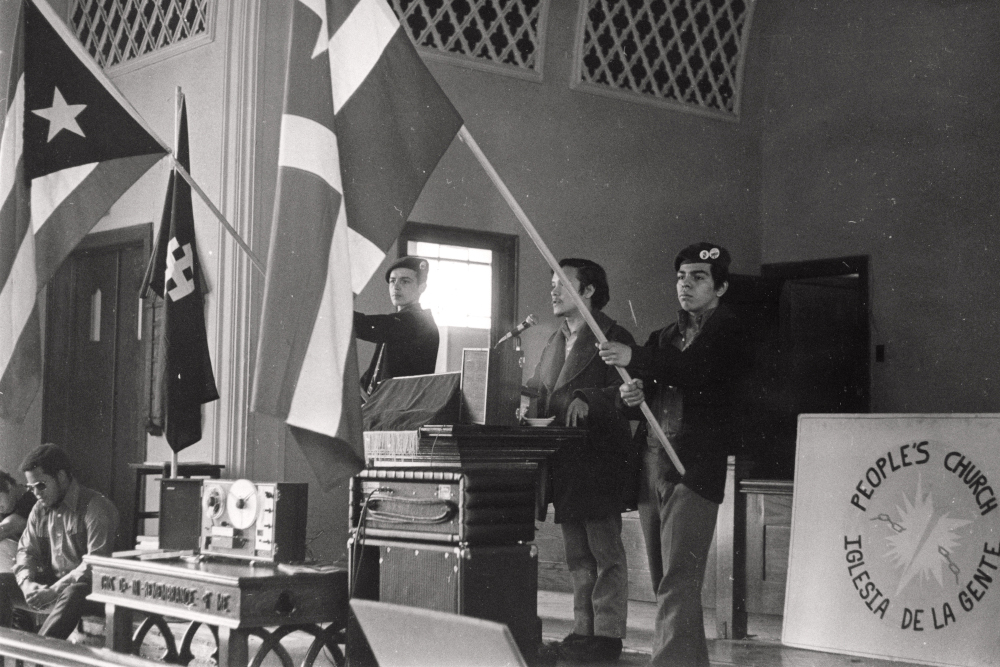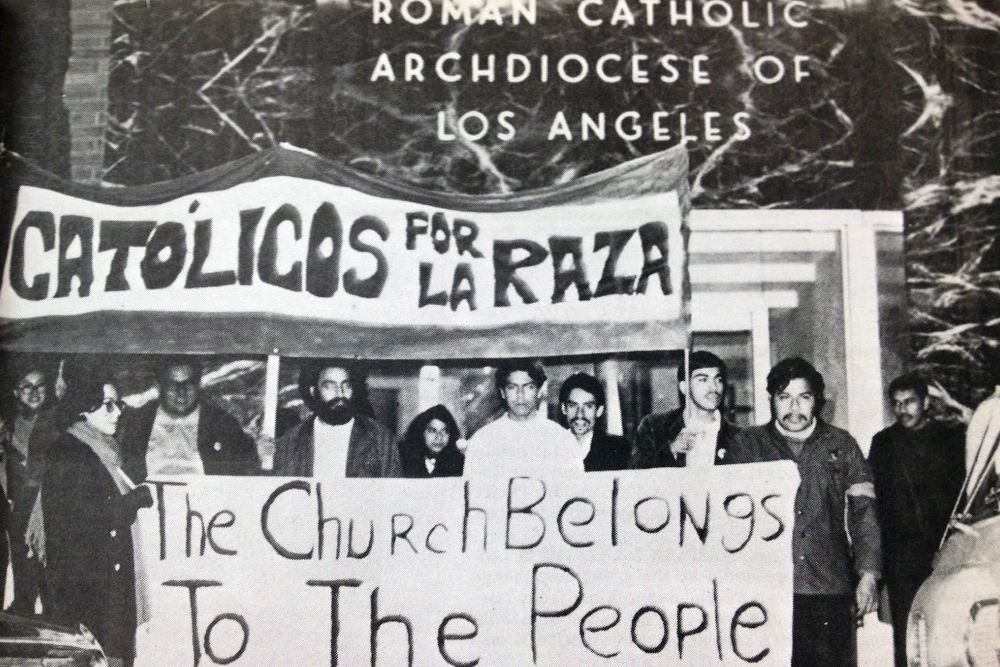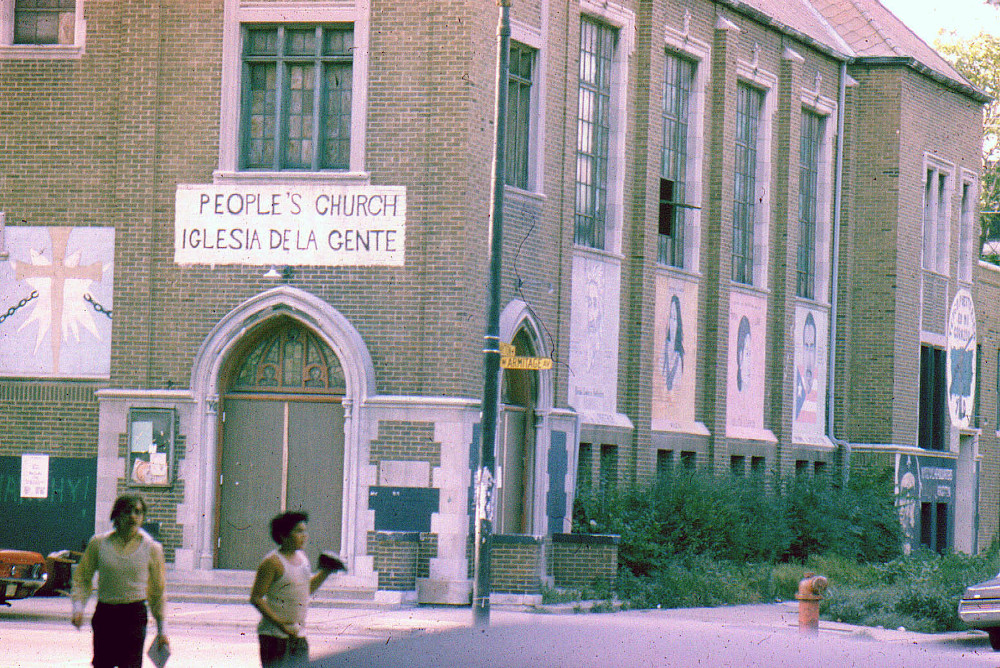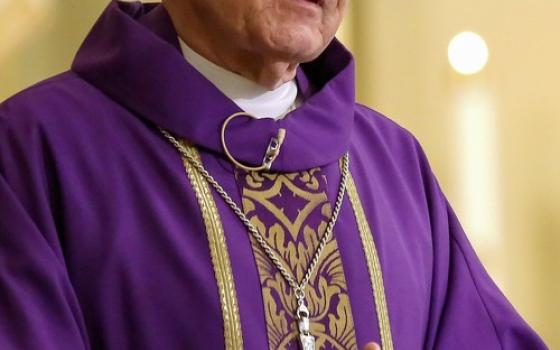
Young Lords members hold flags inside the Armitage Methodist Church in March 1970, commemorating the Masacre de Ponce. (Photo © Carlos Flores)
In the late 1960s and early '70s, Latino activists occupied church buildings across the country as a way of taking back control of their communities and calling attention to local residents' poverty, lack of educational opportunities and displacement amid revitalization plans that hiked up rents.
In a recently published book, Texas A&M historian Felipe Hinojosa gives this little remembered movement a new look, focusing on four cities — Chicago, Los Angeles, New York and Houston — where these "apostles of change," as Hinojosa calls both the groups and his book, inhabited churches to show the "power of the church in neighborhoods across the country."
To these activists, Hinojosa notes, community control begins with the institutions people "perceive to be the most sacred." Latino activists used these spaces to host health clinics, breakfast programs, and art and history classes. They used the grounds to organize, as well as to prompt the churches and institutions to leverage their wealth and power to help their neighbors.
The activism of groups such as the largely Puerto Rican-led Young Lords, the lay Catholic group Católicos por La Raza and the Mexican American Youth Organization, Hinojosa writes, "reminds us that religious lives are both political and spiritual and that churches are not neutral spaces."
Advertisement
But Apostles of Change isn't a book about faith-inspired protest, Hinojosa said. Rather, it looks at how religious outsiders strategically used houses of worship to inspire "faith communities to get involved in the struggles of the neighborhood."
While many know about the activist faith of Cesar Chavez, the farm worker leader who drew inspiration from Catholic social teaching, Hinojosa said it's important to also learn about other local Latino grassroots movements that took place.
"It's important to look beyond the kind of "hero worship" of the civil rights movement and do the kind of research that will help us better tell the stories of Latino grassroots movements," Hinojosa told Religion News Service.
"We know very little about Latino and Latina religious leaders that were prophets, that were religious radicals — people who stood up to faith and justice," Hinojosa added.
In Chicago, the Young Lords, with the help of seminary students, seized McCormick Theological Seminary, which was affiliated with the United Presbyterian Church, in the Lincoln Park neighborhood just before midnight on May 14, 1969.
"Activists accused seminary leaders of standing idly by as urban renewal displaced low-income families in Lincoln Park," Hinojosa writes. The Young Lords and other groups inhabited seminary buildings until May 18 while they negotiated with the school's leaders and demanded that the seminary — which had raised millions of dollars for campus development — fund low-income housing and legal aid as well as facilities for day care and cultural centers.

Católicos por La Raza members demonstrate in Los Angeles. (Photo courtesy of UCLA Chicano Studies Research Center)
Months later, on Christmas Eve in Los Angeles, Católicos por La Raza staged a demonstration outside the wealthy St. Basil Catholic Church, where then-Cardinal James Francis McIntyre was presiding at midnight Mass. They sought to confront McIntyre about what they said was the Catholic Church's neglect of the poor and the lack of Mexican American representation in the institution.
Undercover law enforcement officers, acting as ushers, tried to keep them out, but as Hinojosa recounts, the crowd outside St. Basil chanted, "Let the poor people in! Let the poor people in!" Eventually, several were arrested.
In New York three days later, the Young Lords took over First Spanish United Methodist Church in East Harlem, shutting the doors with railroad spikes after parishioners left church grounds, Hinojosa writes.
They set up a wooden sign with red lettering declaring "La Iglesia De La Gente — People's Church" and transformed the building into a community space and medical treatment area where organizers served breakfast, held art classes and informed residents about lead poisoning. The occupation, which garnered significant media and celebrity attention, ended in early January 1970 after a judge ordered the group to leave.
In mid-February of that year, the Mexican American Youth Organization took over the vacant Christ Presbyterian Church in Houston after church leaders denied the group's proposal to use the space to provide social services for the neighborhood. While occupying the church for almost three weeks, the group organized a breakfast program that fed 40 kids a day and offered art and Chicano history classes.
Although these occupations were short-lived, Hinojosa said these movements shouldn't be discounted.
He details how the occupation in Chicago secured funding for a legal aid office, a health clinic at Armitage Methodist Church and a proposal for low-income housing in Lincoln Park. The demonstration outside St. Basil in Los Angeles, Hinojosa writes, opened the doors for religious reformers within the church.
Citing the work of author Johanna Fernández, Hinojosa notes the Young Lords' occupation in East Harlem "became the staging ground for a 'Nuyorican identity," adding that to this day the First Spanish United Methodist Church is offering mutual aid and food pantry programs that the Young Lords embodied. And in Houston, Presbyterian leaders committed to helping immigrants and continue to do so today, according to Hinojosa.

A banner for the "People's Church" hangs outside Armitage Methodist Church, circa 1970. (Photo © Carlos Flores)
To Hinojosa, these histories are also personal.
The son of a pastor, Hinojosa grew up in an evangelical Mennonite church, a working-class parish that valued mutual aid, which Hinojosa described as "poor people helping poor people."
As a graduate student at the University of Houston, Hinojosa was immersed in Chicano history but said he wondered, "Where is religion, though?"
"The work I do as a historian is to really try to uncover the stories of people like the folks that I grew up with in that church," Hinojosa added.
He learned about activists such as Lydia Lopez, who, after taking part in the demonstration outside St. Basil, helped lead the sanctuary movement in Los Angeles. Hinojosa also spotlights Felipe Luciano of the Young Lords. Raised Pentecostal, he would cite the New Testament to scold church leaders — who rejected their social services plans — for "behaving like the Pharisees of Jesus' day."
"I saw how much these young people put into their vision. This wasn't just reckless. This was very strategic and collective intellectual work and street work that I just found really inspiring," Hinojosa said.






